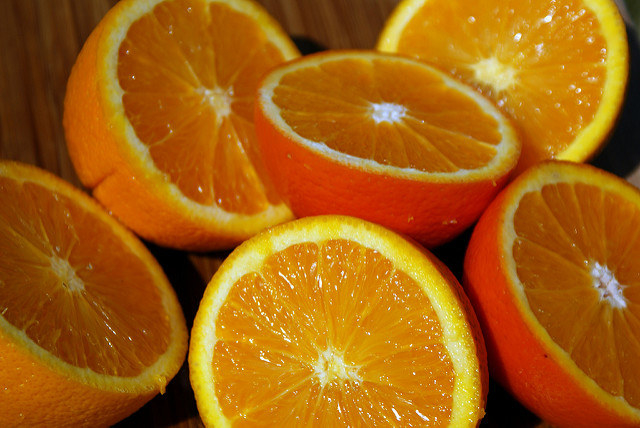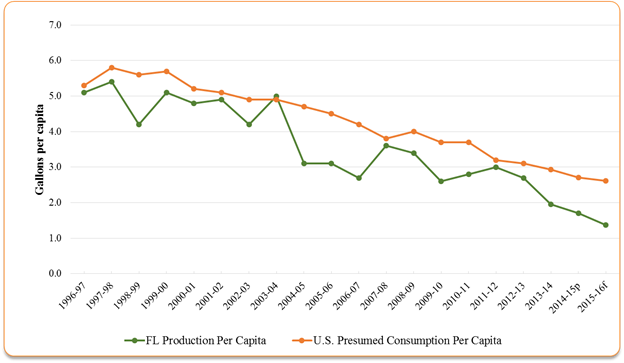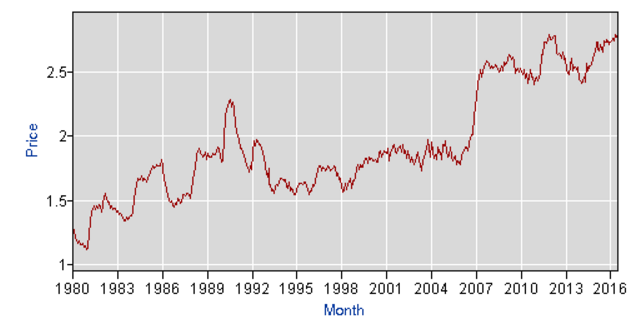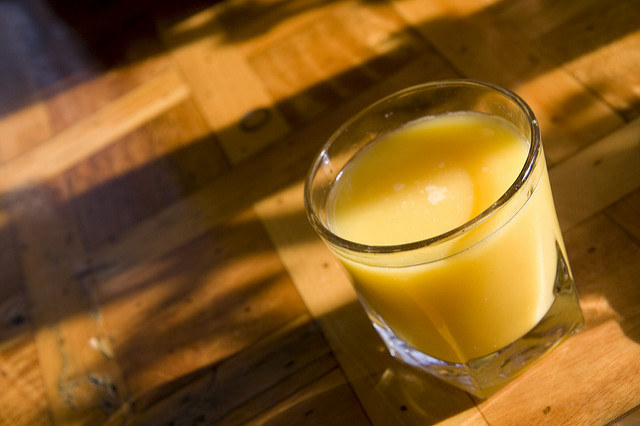
Tropicana recently added a non-GMO label to its orange juices. A Minute Maid commercial emphasizes the use of real fruit. Yet despite such efforts to restore America's thirst for OJ, sales keep falling.
Trendy new cold-pressed juices and juice cleanses haven't helped. In the 12 months to July, sales of refrigerated orange juice dropped 4.1%, according to data from Nielsen. Frozen orange juice sales fell 9.7%.
This isn't just a short-term blip.
The last time orange juice sales rose was back in the 2000-01 growing season, when a Clinton still occupied the White House and George W. Bush had just been elected president. Since then, consumption has fallen by about 45%.
And as the country turns its back on the juice, it slowly disappears from supermarket shelves. On average, refrigerated orange juice lost 9.7% of its shelf space between 2012 and 2014 alone, according to data provided by the Florida Department of Citrus, a government agency. That's an average of 3.4 linear feet of shelf space per store that was once filled with OJ and now contains something else.
So is orange juice in crisis? "Many consumers still enjoy orange juice as it continues to be the top selling 100% fruit juice in the U.S.," a spokesperson for the agency said in an email. "We are working with growers to support their efforts and help share the Florida OJ story with consumers."

Why the carnage? Orange juice sits on the wrong side of a number of changes in consumer tastes, NPD food and beverage analyst Darren Seifer told BuzzFeed News. More people are focusing on cutting excess sugar from their diets, and 8 ounces of Minute Maid 100% orange juice contains 24 grams of sugar — more than a serving of some brands of vanilla ice cream.
"In the big picture, it's about the sugar," said Seifer. "People are consuming less carbonated soft drinks, juice, fruit drinks. The nation is trying to avoid sugar."
In fact, adults recently surveyed by NPD said they pay more attention to sugar content on nutrition labels than anything else, including fat and calories. And they're more likely to be cutting back on sugar as well.
NPD Dieting Monitor data (year Ending Feb. 2016)
What do you usually look for on the Nutrition Facts label (percent of adults):
Sugar: 42%
Calories: 40%
Fat: 31%What are you trying to cut down on/avoid completely (percent of adults):
Sugar: 66%
Calories: 58%
Fat: 63%
Big Citrus says this is a mistake.
"There is a lot of confusion around sugar when it comes to juice," said Shannon Shepp, executive director of the Florida Department of Citrus. She noted that a serving of orange juice contains no added sugar, a fact that will soon be noted on nutrition labels under new US Food and Drug Administration rules.
In addition, a glass of OJ contains more than 100% of the recommended daily value of vitamin C, along with some potassium, folate, and thiamine, and "potassium is in fact a nutrient of concern for most Americans," she said.

On top of changing tastes, the country's orange crop has been devastated. A tree disease called citrus greening was detected in Florida, the main juice orange growing region, in 2005, and it has wreaked havoc on the industry.
“Citrus greening is certainly a factor in the drop in production, with Florida producing half the amount of oranges it did 10 years ago and about one-third the amount it did almost 15 years ago,” Shepp said. “As supply dwindles, the price increases in response.”
Orange juice consumption has declined as production has plummeted.

Meanwhile, retail orange juice prices have climbed.

Unable to cure the disease, the Environmental Protection Agency in August approved the use of three antibiotics, which are sprayed onto the trees, to control the disease.
Is there hope for an OJ rebound? Euromonitor International says the FDA's new nutrition label requirements, which will measure the amount of added sugar in the total sugar count, could help.
“Although most juices are high in sugar, if consumers are more easily able to differentiate between products with naturally occurring sugar and those with added sugar, some juice categories may be able to shed some of the perceptions of offering unhealthy beverages," Euromonitor wrote in a report.
"By contrast, juice drinks and nectars with high levels of added sugar might suffer from such labeling changes.”

